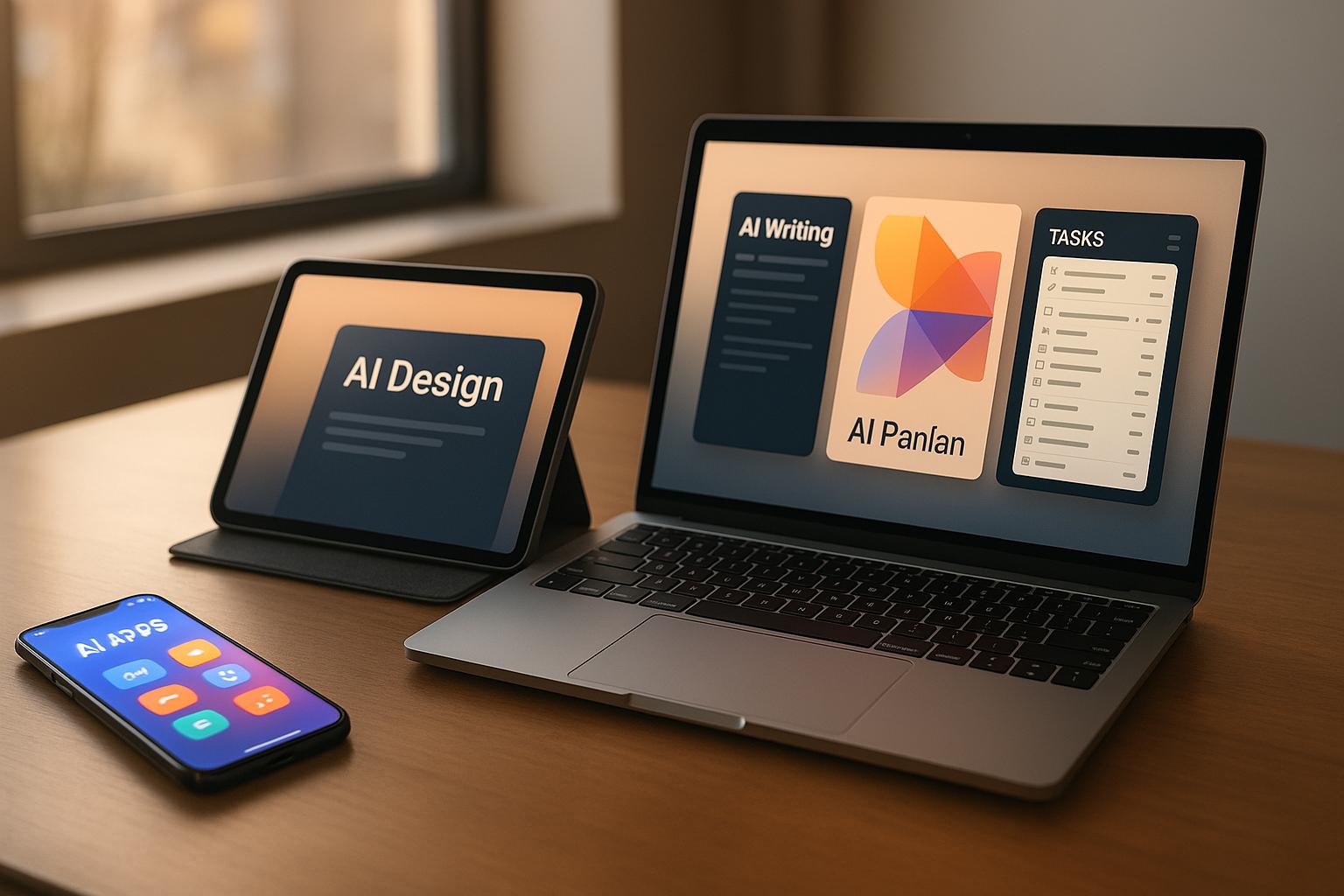Artificial intelligence is transforming education by saving teachers time, personalizing learning, and making lessons more engaging. This article introduces 10 AI tools that help with lesson planning, grading, and student engagement, while offering practical ways to implement them in classrooms.
Key Takeaways:
- Save Time: Automate tasks like grading, attendance, and lesson planning.
- Personalized Learning: Tools like MATHia adjust to each student’s pace and style.
- Boost Engagement: Use gamified exercises, real-time feedback, and virtual learning platforms.
Quick Overview of the Tools:
- Lesson Planning Tools: Automatically create tailored lesson plans.
- Student Work Analysis: Provide detailed feedback and track progress.
- Adaptive Learning Systems: Adjust content difficulty in real time.
- AI-Powered Help Desks: Answer questions and summarize documents.
- Virtual Learning Platforms: Offer simulations and immersive experiences.
- Writing Assistance: Improve grammar, style, and structure instantly.
- Classroom Management: Track attendance and monitor behavior.
- Language Assistance: Translate and support multilingual classrooms.
- Educational Games: Make learning fun and interactive.
- Performance Tracking: Generate detailed progress reports.
How to Start:
- Begin with simple tools for tasks like quizzes or feedback.
- Align tools with teaching goals, such as personalizing learning or boosting engagement.
- Train teachers and students on proper use and data privacy.
AI can’t replace teachers but can make classrooms more efficient and engaging. Dive in to see how these tools can reshape your teaching approach.
Key Benefits of AI in Education
Reducing Administrative Work
Teachers often spend valuable time on repetitive administrative tasks, cutting into the time they could dedicate to teaching. AI tools are changing that by taking over many of these duties. For example, EssayGrader has enabled more than 60,000 teachers to cut grading time from 10 minutes to just 30 seconds per essay.
AI simplifies administrative tasks like:
- Organizing lesson plans and resources in one place
- Automatically tracking attendance
- Sending smart deadline reminders
- Generating detailed progress reports
With these tools, educators can shift their attention to strategies that focus directly on students.
Creating Custom Learning Paths
AI uses performance data to create tailored learning experiences. For instance, Carnegie Learning's MATHia employs machine learning to deliver personalized math instruction, helping students advance at their own pace while addressing specific needs.
Some key benefits of personalized learning paths include:
- Continuous progress tracking
- Automatic adjustments to difficulty levels
- Pinpointing knowledge gaps
- Recommending targeted resources
- Accommodating various learning styles
These tailored approaches not only enhance individual learning but also make classroom interactions more dynamic.
Making Learning More Interactive
AI tools go beyond efficiency and personalization to make lessons more engaging. Platforms like Squirrel AI provide students with customized support and exercises designed to tackle their unique challenges.
Features of these interactive tools include:
- Real-time feedback to guide students
- Simulations that bring concepts to life
- Adaptive practice exercises tailored to each student
- Gamified elements to boost motivation
- Virtual learning environments for immersive experiences
Additionally, for multilingual classrooms, AI offers real-time translation, ensuring that language differences don’t hinder learning progress.
Top 10 A.I. Tools For Teachers 2025
10 AI Tools Teachers Can Use in the Classroom
Here are ten AI-driven tools designed to simplify teaching tasks and improve classroom experiences:
1. Lesson Planning Tools
These tools create tailored lesson plans that align with curriculum standards and cater to student interests. As of July 2023, 63% of teachers reported integrating AI tools into their classrooms.
Key features include:
- Generating learning objectives automatically
- Suggesting activities tailored to the lesson
- Recommending resources
- Supporting differentiated instruction
2. Tools for Analyzing Student Work
These tools provide detailed feedback on student assignments, highlight areas for improvement, and track individual learning progress. Teachers can use them to identify common mistakes and offer personalized guidance.
3. Adaptive Learning Systems
Adaptive learning systems adjust lesson difficulty in real-time based on how students are performing. This ensures that each student progresses at a pace suited to their abilities.
4. AI-Powered Help Desks
ChatGPT Edu, launched in May 2024, is specifically designed for higher education. It prioritizes privacy by not using conversations or data for model training and offers features like document summarization and tools for creating custom GPT models for both students and educators.
5. Virtual Learning Platforms
AI-powered virtual platforms enhance traditional teaching methods with features like simulations and virtual field trips, creating immersive experiences for students.
6. Writing Assistance Tools
These tools help students improve their writing with instant feedback on grammar, style, and structure, making the editing process more efficient.
7. Classroom Management Tools
Classroom management systems handle tasks like attendance tracking and monitoring class behavior, giving teachers more time to focus on instruction.
8. Language Assistance Tools
AI tools for language support provide real-time translation and language learning help, making communication easier in multilingual classrooms. Some also include interactive activities like AI-driven language games.
9. Educational Games
Interactive AI-based games adapt to a student's performance, turning lessons into engaging activities that encourage participation and active learning.
10. Performance Tracking Tools
These tools generate reports to monitor student progress, evaluate skills, anticipate outcomes, and understand learning preferences.
Choosing the right tools for your teaching objectives is crucial to making the most of these AI solutions in the classroom.
sbb-itb-212c9ea
Getting Started with AI Tools
Start with Simple AI Tools
Kick things off by using one or two straightforward AI tools to make everyday teaching tasks easier. These tools can help with:
- Drafting worksheets
- Creating quiz questions
- Outlining lessons
- Designing student feedback templates
The key is to choose tools that fit your teaching style and goals to get the best results.
Align Tools with Your Teaching Objectives
Pick AI tools that directly support your educational goals. A clear plan can help you integrate them effectively. Here's an example:
| Teaching Goal | How AI Can Help | What to Expect |
|---|---|---|
| Personalized Learning | Adaptive Learning Systems | Tailored learning paths |
| Writing Skills | Writing Assistance Tools | Instant feedback |
| Boosting Engagement | Educational Games | More interactive lessons |
| Assessments | Performance Tracking | Insights from data |
Fine-tune AI prompts and outputs to better match your students’ needs.
Prepare Teachers and Students for AI Use
Once you've chosen tools and set a plan, preparation is key to seamless implementation. Proper training ensures everyone understands how to use AI effectively. Here's how to get started:
-
Teacher Training
Equip teachers with practical skills to use AI tools in the classroom. Make sure they know both the strengths and limitations of the technology. -
Student Guidelines
Set clear rules for using AI responsibly. Teach students how to evaluate AI-generated content critically and maintain academic honesty. -
Data Privacy
Put strong measures in place to protect student data while using AI platforms.
Providing proper training is essential for smooth integration. For instance, Mastery Coding’s "AI Essentials for Educators" course is a great resource to help teachers build foundational AI skills.
Conclusion: Making AI Work in Education
AI is reshaping education by improving learning experiences and easing administrative tasks. Stanford Professor Karen Brennan highlights this potential:
"What we know about learning is not reflected in how we teach. Teachers know that learning happens through powerful classroom discussions. AI can help support a single teacher trying to generate 35 unique conversations with each student".
This emphasizes the need to approach AI integration thoughtfully. Instead of replacing traditional teaching methods, AI adds value by personalizing learning and allowing teachers to focus more on engaging with students.
Here are some practical ways to integrate AI into education:
| Focus Area | Implementation Strategy | Expected Outcome |
|---|---|---|
| Student Engagement | Use AI to provide individualized prompts | More meaningful student interactions |
| Teacher Efficiency | Automate repetitive tasks like grading | More time for direct teaching |
| Learning Quality | Develop personalized learning paths | Improved understanding of material |
| Critical Thinking | Train students to assess AI-generated content | Better critical analysis skills |
For AI to truly enhance education, it must align with strong teaching principles and embrace innovative approaches.
FAQs
How can teachers protect student data and ensure privacy when using AI tools in the classroom?
To protect student data and ensure privacy when using AI tools, teachers should start by consulting their school district to confirm which tools are approved and meet privacy standards. Choose platforms with clear privacy policies that outline what data is collected, how it’s used, and whether it’s shared with third parties.
Avoid entering personal or sensitive student information into AI tools. Instead, use these tools as a complement to your teaching, not a replacement. Schools should also establish clear data protection policies, conduct regular security reviews, and provide training for staff to stay informed about best practices. These steps can help create a safer, more secure learning environment while leveraging AI effectively.
What are the best ways to help teachers and students effectively use AI tools in the classroom?
To help teachers and students use AI tools effectively, start with professional development sessions tailored for educators. These sessions can focus on hands-on training, demonstrating how AI tools can streamline tasks like grading, lesson planning, and personalizing learning experiences.
For students, encourage the use of AI tools in research, projects, and problem-solving activities. This not only builds their technical skills but also fosters critical thinking. Teachers can further enhance understanding by leading discussions on the differences between AI-generated and human-created content, helping students evaluate the strengths and limitations of these tools.
Lastly, create a supportive environment where both teachers and students feel comfortable experimenting with AI tools, asking questions, and sharing feedback to continually improve their use in the classroom.
How can educators use AI tools to effectively support their teaching goals and enhance student learning?
To effectively support teaching goals and enhance student learning, educators should align AI tools with their specific objectives. For example, AI can help streamline administrative tasks, such as grading or scheduling, giving teachers more time to focus on instruction. It can also personalize learning experiences by adapting content to individual student needs, ensuring that every learner progresses at their own pace.
When choosing AI tools, consider your teaching goals, the needs of your students, and their grade level. Start small by integrating tools that address immediate challenges, like improving engagement through interactive lessons or automating repetitive tasks. With thoughtful implementation, AI can become a powerful ally in creating a more effective and engaging classroom experience.



